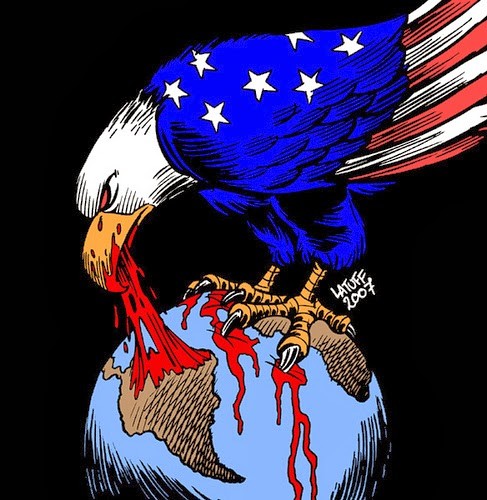Buyout Kleptocrats
Post on: 26 Апрель, 2015 No Comment

Nice illustration of criminal tricks used by private equity (from comment by jomellon to [Mar 30, 2009]The revival of American populism Will there be blood The Economist )
March 29, 2009
The Problem that The Economist wants to talk about? Public Outrage a.k.a. Populism.
The other less important problem that a magazine called The Economist might want to address, but which it doesnt want to talk about: the economy is bust, and why.
Typical scenario for the last 18 years:
- January - Private Equity Investor (PEI) has 20 million. He uses it a security to borrow 200 mio from Bank1 to buy a company Widgets. Widgets is a solid manufacturing business with assets of land, factories, patents, a brand, good will and no debts.
- March — Widgets borrows 300 million from Bank2 – no problems, its a solid business – but here comes the bit where it all goes criminal, but not illegal. Widgets pays out 300 million to PEI its owner as a dividend, who repays 200 to Bank1. PEI now has 100 million cash, and has done nothing for it. Widgets however has to pay 20 million in interest per year. PEI now has 100 million.
- July — Widgets also sells its assets: land, patents and so on and leases them back for 30 million a year. The sales bring 200 million which Widgets also pays out to PEI its owner. PEI now has 300 million.
- August — Widgets Pension Fund is restructured bringing a liquid 150 million onto the balance sheet. Widgets has liabilities to its pensioners with little to back them. 150 million is paid out to PEI as a special dividend. PEI now has 450 million.
- December — PEI sells the business to a pension fund, for 100 million, less than he paid as it has a lot of debt, but it is a good business. PEI now has 550
- Recap: Widgets now has 300 million debt causing 20 million a year in interest, plus 30 million in leasing payments. It has pension liabilities and the pension fund is almost worthless. PEI had 20 million at the start of the year and now has 550 million. But the business is still viable, as Widgets can meet its payments.
- 5 years later — Sadly hard times come. Turnover drops, prices drop, costs are cut, people lose their jobs, including engineers, managers, the shop floor and the sales team who did real work for years, created real value, invented the patents, built the brand. It doesnt help. The company has no stores of fat — it goes bust. The banks loans are sour. People lose their jobs, the pensioners cannot be paid.

This happens 100 times so the banks are bust too, but get bailed out by the taxpayer (thats those guys who lost their jobs and pensions at Widgets)
PEI lives happily in The Bahamas with the 550 million which he earned in a fabulous year of value creation made possible by the power of free and light touch regulated markets.
Sadly, due to the complexity of all this the bright chaps at The Economist can not quite see why this is a slightly problematic way to run an economy. Honi suit qui mal y pense.
And if you are wondering whether firms like hedge funds and private equity funds — significant parts of the shadow banking system — add real value to the economy, you might enjoy this article by Harlan Platt about private equity, The Private Equity Myth. Download Platt. The Private Equity Myth .
The juggernaut of Kohlberg Kravis Roberts & Co. began rolling in 1976 when Jerome Kohlberg and cousins Henry Kravis and George Roberts left Bear, Stearns with about $120,000 to spend. The three invented and dominated the leveraged buyout as they sought investors and borrowed money to acquire Fortune 500 companies in dizzying succession.
Time after time, the KKR men presented a tempting offer. The CEO could cash out his companys existing shareholders by agreeing to sell the company to a new group that would be headed by KKR, but would include a lot of room for existing management. The new ownership group would take on a lot of debt, but aim to pay it off quickly. If this buyout worked out as planned, the KKR men hinted, the new owners could earn five times their money over the next five years. Presented with such a choice in the frenzied takeover climate of the 1980s, manages and corporate directors again and again said yes… To top management a leveraged buyout was the most palatable way to ride out the merger-and-acquisition craze.
They put up very little money of their own funds, but their partnerships made out like bandits. Consider the case of Owens-Illinois: KKR pup up only 4.7 percent of the purchase price. The companys chairman earned $10 million within a few years, the takeover advisors got $60 million, Owens-Illinois was left gaunt and scaled back, and about five years later, KKR took it public at $11 a share, more than twice what the KKR partnership had paid for it.
Discussing the $26.4 billion buyout of RJR Nabisco Inc. «Anders goes beyond what has been previously published, Bianco wrote, with his convincing assertion that RJRs post-deal crises pushed KKR close to ruin. Leveraged buyouts in general Anders terms «one of the most profoundly undemocratic ventures the United States had ever seen. Their only lasting impact, he says, was to shift wealth from the mass of corporate employees to a managerial elite allied with Wall Street.
For the first fourteen years of KKRs existence, the buyout firms hallmark could be expressed in one word: debt… As KKR grew evermore powerful, Kravis and Roberts derived their economic clout from a single fact: They could borrow more money, faster, than anyone else, according to the chronicler of this high-flying firm. KKR acquired $60 billion worth of companies in wildly different industries in the 1980s: Safeway Stores, Duracell, Motel 6, Stop & Shop, Avis, Tropicana, and Playtex. They made piles of money by deducting interest expenditures from their taxes, cutting costs in their new companies and riding a long-running bull market.
This behind-the-scene accounts shows the ambition, pride, envy and fear that characterized the debt mania largely engineered by KKR, a mania that put millions out of work and made a very few very rich.














